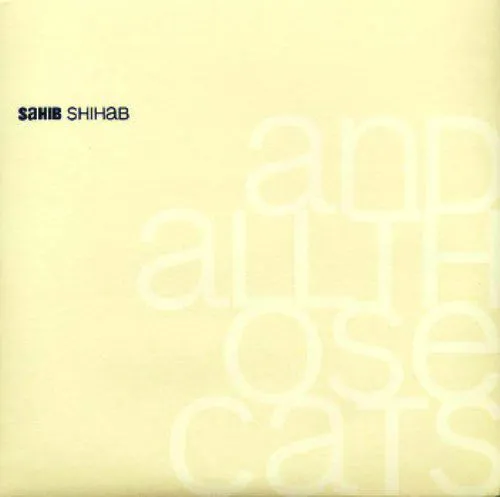- 2LP
- Recommended
- Back In
Sahib Shihab
And All Those Cats
Rearward - Cat No: RW102LP
- updated:2025-06-01
「サヒブ・シハブは、多くの点でバリトン・サックス界のセロニアス・モンクだった」 〈Rearward〉から、ヨーロッパに渡ったSahib Shihabが1964 年から1970年にかけて、同じくアメリカからパリに渡っていた最強ドラマーKenny Clarke、ベースJimmy Woode、ベルギーのFrancy BolandやFats Sadiたちと録音した音源をコンパイルした名作2LP。ストックしています。
Track List
-
A1. Set Up
2:57 -
A2. Peter's Waltz
4:52 -
A3. Yah, Yah Blues
3:59 -
A4. End Of A Love Affair
3:58 -
B1. Om Mani Padme Hum
5:42 -
B2. Bohemia After Dark
3:38 -
B3. Campi's Idea
8:25 -
C1. Jay-Jay
2:52 -
C2. Waltz For Seth
6:17 -
C3. Herr Fixit
5:29 -
C4. Stoned Ghosts
5:00 -
D1. Companionship (I+II)
4:13 -
D2. CT+CB
5:20 -
D3. Djdar, Djar
4:20 -
D4. Talk Some Yak-Ee-Dak
3:48
Sahib Shihab was, in many ways, the Thelonious Monk of the baritone saxophone. Like Monk, he was an uncompromising individualist with an idiosyncratic, often quirky, approach to improvisation. And, in fact, Shihab and Monk had a strong mutual affinity. They worked together in the late forties and early fifties and became good friends. Shihab admired Monk for his oblique approach to jazz and his resolute non-con- formity and he shared much of Monk's musical philosphy.
He joined Luther Henderson's band before he was 16 but left soon afterwards to enrol for a year at Boston Conservatory. He then had a two year spell with Fletcher Henderson and later worked with Roy Eldridge. It was after he heard Charlie Parker that Shihab's music became strongly bop orientated.
He did his first record date with Thelonious Monk in November 1947 and later he worked with Art Blakey, Tadd Dameron, Dizzy Gillespie, Oscar Pettiford, John Coltrane and Illinois Jacquet. It was in 1951 that he added baritone saxophone to his range of instruments.
When the opportunity came, in 1959, to join the band of Quincy Jones for a tour of Europe with the musical Free And Easy, Shihab accepted it with alacrity because he had become disullusioned with the politics and racism of the United States. And when the tour ended, Shihab decided to remain in Europe, settling in Copenhagen, where he taught at the Polytechnic High School and also composed music for the cinema, television and the theatre.
Shihab joined the Clarke-Boland Big Band in 1961 and remained a regular member of the ensemble untii it broke up in April 1972. He returned to the United States for a three-year spell in 1973, basing himself in Los Angeles, then moved back to Europe for a further period. In 1986 he went back once ag ain to America. He died in Tennessee on October 24, 1989.
The small group dates here were recorded between 1964 and 1970 and showcase the delighyfully eccentric, unorthodox improvisational style of Shihab on baritone saxophone and flute.
He joined Luther Henderson's band before he was 16 but left soon afterwards to enrol for a year at Boston Conservatory. He then had a two year spell with Fletcher Henderson and later worked with Roy Eldridge. It was after he heard Charlie Parker that Shihab's music became strongly bop orientated.
He did his first record date with Thelonious Monk in November 1947 and later he worked with Art Blakey, Tadd Dameron, Dizzy Gillespie, Oscar Pettiford, John Coltrane and Illinois Jacquet. It was in 1951 that he added baritone saxophone to his range of instruments.
When the opportunity came, in 1959, to join the band of Quincy Jones for a tour of Europe with the musical Free And Easy, Shihab accepted it with alacrity because he had become disullusioned with the politics and racism of the United States. And when the tour ended, Shihab decided to remain in Europe, settling in Copenhagen, where he taught at the Polytechnic High School and also composed music for the cinema, television and the theatre.
Shihab joined the Clarke-Boland Big Band in 1961 and remained a regular member of the ensemble untii it broke up in April 1972. He returned to the United States for a three-year spell in 1973, basing himself in Los Angeles, then moved back to Europe for a further period. In 1986 he went back once ag ain to America. He died in Tennessee on October 24, 1989.
The small group dates here were recorded between 1964 and 1970 and showcase the delighyfully eccentric, unorthodox improvisational style of Shihab on baritone saxophone and flute.




ビバップ・スタイルのドラムの革命的な天才、パリに渡り、ヨーロッパとアメリカのジャズミュージシャンの架け橋的役割も果たしたケニー・クラーク、ヨーロピアン・ジャズ最高峰とも言われるClarke-Boland Big Band関連の一連の音源の中でも、奇跡のような高いレベルでのセッションが残されたハイライトの一つ。クインシー・ジョーンズのツアーでヨーロッパに渡り、ケニー・クラーク同様そのままコペンハーゲンにとどまったサックス、フルート奏者サヒブ・シハブとの録音の数々です。彼らの結成を仕掛け、支えたGigi Campi自身による監修の元1997年に伊〈Schema〉の再発レーベル〈Rearward〉からリリースさた二枚組のコンピレーション・アルバム。怪物たちの圧巻のスイングを是非。 (サイトウ)